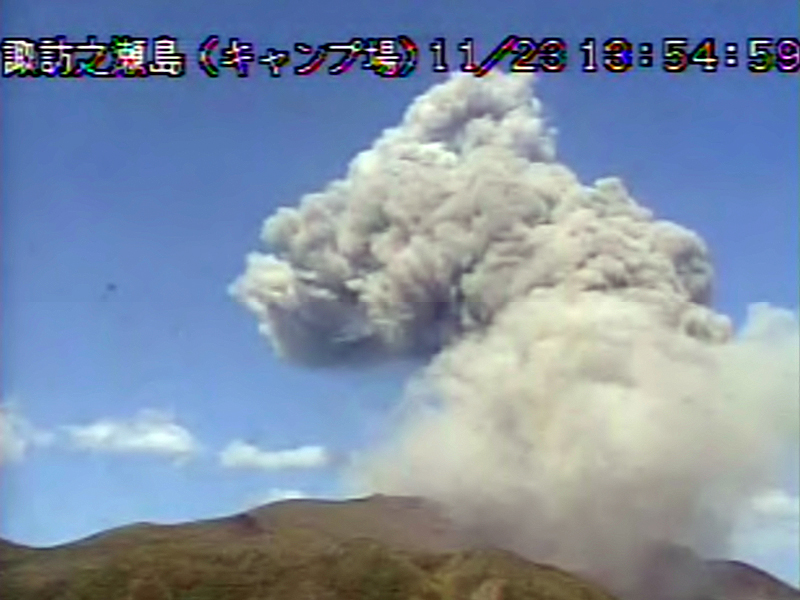Report on Suwanosejima (Japan) — January 2019
Bulletin of the Global Volcanism Network, vol. 44, no. 1 (January 2019)
Managing Editor: Edward Venzke.
Edited by A. Elizabeth Crafford.
Suwanosejima (Japan) Multiple explosive events with incandescence and ash plumes during November 2018
Please cite this report as:
Global Volcanism Program, 2019. Report on Suwanosejima (Japan) (Crafford, A.E., and Venzke, E., eds.). Bulletin of the Global Volcanism Network, 44:1. Smithsonian Institution. https://doi.org/10.5479/si.GVP.BGVN201901-282030
Suwanosejima
Japan
29.638°N, 129.714°E; summit elev. 796 m
All times are local (unless otherwise noted)
Suwanosejima, an andesitic stratovolcano in Japan's northern Ryukyu Islands, was intermittently active for much of the 20th century, producing ash plumes, Strombolian explosions, and ash deposits. Continuous activity since October 2004 has produced intermittent explosions, generating ash plumes in most months that rise hundreds of meters above the summit to altitudes between 1 and 3 km. Ongoing activity for the second half of 2018 is covered in this report with information provided by the Japan Meteorological Agency (JMA) and the Tokyo Volcanic Ash Advisory Center (VAAC).
Activity during July-December 2018 was intermittent with explosions reported twice in September and 21 times during November. Incandescent activity was observed a few times each month, increasing significantly during November. Thermal data support a similar pattern of activity; the MIROVA thermal anomaly graph indicated intermittent activity through the period that was most frequent during October and November (figure 33). MODVOLC thermal alerts were issued once in September (9), three times in October (7, 21), and four times on 14 and 15 November.
There were no explosions at Suwanosejima during July or August 2018; steam plumes rose 900-1,000 m above the crater rim and incandescence was intermittently observed on clear nights. During September incandescence was also observed at night; in addition, explosions were reported on 12 and 13 September, with ash plumes rising 1,100 m above the crater rim. October was again quiet with no explosions, only steam plumes rising 800 m, and occasional incandescence at night, although thermal activity increased (figure 33).
More intense activity resumed during November 2018 with 21 explosions reported. On 9 and 14 November tephra was ejected up to 700 m from the Otake crater. The Tokyo VAAC reported an ash plume visible in satellite imagery at 2.4 km altitude moving E on 14 November. The next day, a plume was reported at 2.7 km altitude drifting NW but it was not visible in satellite imagery. JMA reported gray ash plumes that rose up to 2,000 m above the crater rim on 16 and 23 November (figure 34). The ash plume on 23 November was visible in satellite imagery drifting N at 2.7 km altitude. On 30 November the Tokyo VAAC reported an ash plume visible in satellite data drifting SE at 2.4 km altitude. Incandescence was often observed at night from the webcams throughout the month. Ashfall was confirmed in the village 4 km SSW on 14, 17, and 23 November, and sounds were reported on 20 November.
During December 2018, no explosive eruptions were reported, but an ash plume rose 1,800 m above the summit on 26 December. Incandescence was observed on clear nights in the webcam. Throughout 2018, a total of 42 explosive events were reported; 21 of them occurred during November (figure 35).
Geological Summary. The 8-km-long island of Suwanosejima in the northern Ryukyu Islands consists of an andesitic stratovolcano with two active summit craters. The summit is truncated by a large breached crater extending to the sea on the E flank that was formed by edifice collapse. One of Japan's most frequently active volcanoes, it was in a state of intermittent Strombolian activity from Otake, the NE summit crater, between 1949 and 1996, after which periods of inactivity lengthened. The largest recorded eruption took place in 1813-14, when thick scoria deposits covered residential areas, and the SW crater produced two lava flows that reached the western coast. At the end of the eruption the summit of Otake collapsed, forming a large debris avalanche and creating an open collapse scarp extending to the eastern coast. The island remained uninhabited for about 70 years after the 1813-1814 eruption. Lava flows reached the eastern coast of the island in 1884. Only about 50 people live on the island.
Information Contacts: Japan Meteorological Agency (JMA), Otemachi, 1-3-4, Chiyoda-ku Tokyo 100-8122, Japan (URL: http://www.jma.go.jp/jma/indexe.html); Tokyo Volcanic Ash Advisory Center (VAAC), 1-3-4 Otemachi, Chiyoda-ku, Tokyo, Japan (URL: http://ds.data.jma.go.jp/svd/vaac/data/).




